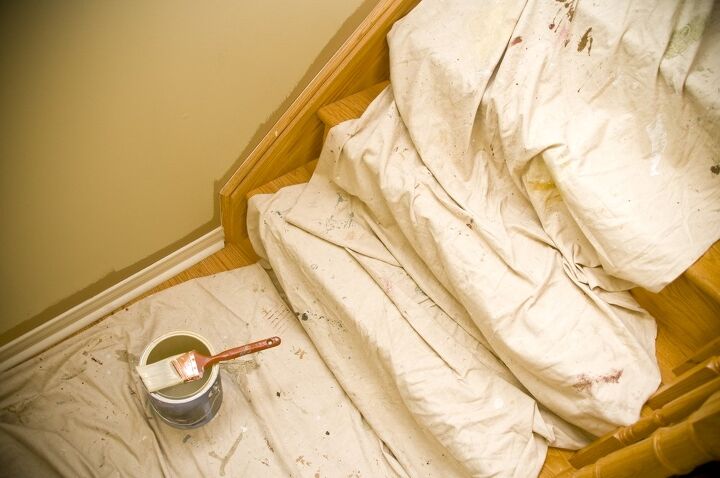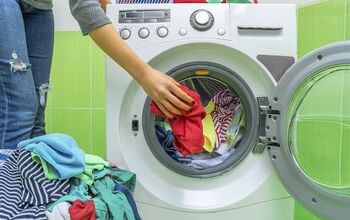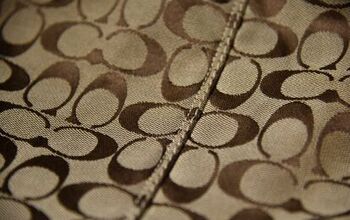Can You Wash A Tarp In The Washing Machine?

By the nature of their design, tarps keep the elements away, but they get grimy in the process. No one wants a mud-encrusted tarp sitting on their garage shelf. But how easy are they to clean? Can you put them in the washing machine?
Depending on the material, you may be able to wash a tarp in the washing machine. The best type of washer for a tarp is one without an agitator. Whether hand-washing or machine-washing, always use cool or cold water and a mild detergent.
A Quick Word on Washers
Washing machines can either be top-load or front-load. Top-load washers have an agitator running through the center of the drum that twists and turns during a wash cycle. The agitator literally agitates the dirt from the laundry. Some top-load washers may have an impeller instead of an agitator.
Front-load washers don’t have an agitator. Rather, their drum tumbles the laundry to remove the dirt and grime. They are often a much gentler machine.
Types of Tarp Materials
Tarps come in a variety of materials and treatments. Some of the most common include the following:
- Mesh Tarps
- Fire Retardant Canvas Tarps
- Untreated Canvas Tarps
- Poly, PVC, or Vinyl Tarps
The type of material from which your tarp is made plays an important role in how you wash and care for it.
Washing Your Tarp
Different materials require different washing guidelines. Some can be washed in a machine, while others can’t. Once you know the material of your tarp, you’ll have a better understanding of how to clean it.
Regardless of the material, all tarps require cool water—never hot. Use mild detergent or dish soap and forgo the harsh chemicals. For a green cleaning option, mix rubbing alcohol with water and spray it on the tarp. The gentler, the better. It seems contradictory given all that tarps withstand!
Mesh Tarps
The recommendation for mesh tarps is to hand-wash them. These tarps can be easily damaged by the agitation of a washer. In a top-load washer, you risk the tarp catching on the agitator. Even a front-load washer may still be too rough for the structure of a mesh tarp.
To hand-wash a mesh tarp, fill a tub or sink with cool water and mild dish soap. Let it soak to loosen any dust or debris. Rinse the tarp thoroughly and hang it to dry.
Fire Retardant Canvas Tarp
Because of their fire retardant coating, these tarps need special care when washing. The gentlest approach would be to hand-wash a fire retardant canvas tarp. Use a gentle detergent and cool or warm water. Line dry completely before folding and storing.
Do not use the following when washing a fire retardant canvas tarp as they affect the coating.
- Hard water or water that leads to mineral build-up
- Bleach
- Starch
- Fabric softeners
Untreated Canvas Tarps
Most canvas tarps are machine-washable but always refer to the care instructions beforehand. Untreated canvas tarps are the easiest to clean. They can go in the washing machine on a gentle cycle with cool water and mild detergent.
Even though they are washing machine-safe, it may still be tough to wash a canvas tarp in a top-load washer. As mentioned above, the agitator tends to get in the way, particularly for oversized loads. If you have a top-load washer, you can remove the agitator before washing your canvas tarp.
Depending on your tarp’s care instructions, you may be able to dry it in the dryer.
Poly, PVC, or Vinyl Tarps
These tarps are made to be 100% waterproof, and their materials are essentially plastic. For the benefit of all readers, let me state the obvious: you should not put plastic in a washing machine. Tarps made of poly, PVC, or vinyl cannot go in the washing machine.
To clean a plastic tarp, hang it over a smooth surface, like a privacy fence. Spread it out as much as you can or work in small sections. Use a soft-bristle brush or sponge and mild dish soap to gently scrub stains. Note: a hard-bristle brush can damage the tarp.
Try not to step on the tarp too much. For hard-to-reach sections, use a pool brush with a telescoping wand.
Spread it out completely on a fence or your driveway and let it air dry. Make sure it’s not folded over in any spots, otherwise, mold can form. Never put a plastic tarp in the dryer.
Drying Your Tarp
As you can see, most tarp material should not go in the dryer. Oftentimes, the heat damages the materials. Opt, instead, to hang it on a laundry line or lay it flat.
Cleaning and drying a tarp seems very much like an outside activity. But if for some reason, you dry it indoors, make sure the room has good air circulation. You can run fans to speed up the process, but do not use heaters.
Make sure the tarp is completely dry before folding and storing it away.
Related Questions
How do you maintain tarps?
Aside from washing and completely drying your tarp, there are a few other ways to maintain it. The biggest thing is to store it when it’s not in use. Leaving the tarp to the elements will only shorten its life. Store it in a location without extreme temperature fluctuations, like a basement or insulated garage. Also, keep it off the ground and out of the sunlight.
How do you clean mildew off of a tarp?
You can either get a store-bought solution or create your own. Add ¼-cup baking soda to every 2 cups of white vinegar. Spray or brush the solution on the tarp and let it sit for 15 minutes. Scrub with a soft-bristle brush and rinse with a hose.
Summary
Tarps should be cleaned before storing, but whether or not they are machine-washable depends on their material.
Mesh and fire retardant canvas tarps should be hand-washed, while untreated canvas can usually go in the washing machine. Tarps made from plastic need to be scrubbed and rinsed outside.
Related Guide

Brigid Levi is a wife, mother, and freelance writer who enjoys a good DIY project and creating beautiful spaces within her home. From cleaning and organization hacks to home decor ideas, she loves helping people in their quest to turn a house into a home. Her hobbies include pretending to be Joanna Gaines while updating her home with her husband and performing in local theater productions.
More by Brigid Levi






















![Standard Dining Room Table Dimensions [for 4, 6, 8, 10 and 12 People]](https://cdn-fastly.upgradedhome.com/media/2023/07/31/9074335/standard-dining-room-table-dimensions-for-4-6-8-10-and-12-people.jpg?size=350x220)




